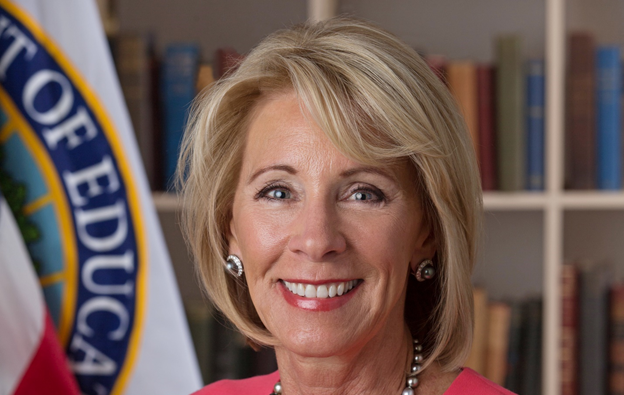DeVos Wants to Prioritize Education Funding for Opportunity Zones – By Lauren Camera, US News and World Report
SECRETARY OF EDUCATION Betsy DeVos wants to prioritize federal education funding for areas of the country that qualify as opportunity zones – a move that if finalized, could shift hundreds of millions of dollars away from some communities and to others.
As part of the 2017 tax law, the Trump administration has certified more than 8,700 opportunity zones, which provide tax incentives to attract investment in business or real estate located within certain economically disadvantaged neighborhoods with the goal of revitalizing those areas. But it's unclear whether policies like opportunity zones actually benefit distressed communities at all, let alone move the needle on education achievement.
DeVos' proposal, published Monday in the Federal Register, would give priority to applicants who propose projects in those opportunity zones for more than 80 education grant competitions, which collectively total more than $700 million.
DeVos initially teased the idea in April, when in response to a question about how the Department of Education could partner with other agencies and invest more in vulnerable students, she told a group of state chief education officers that opportunity zones could do a lot to revitalize economically devastated neighborhoods that in turn could improve the lives of students who live there.

Universities are expanding cybersecurity education to meet broad demand – By Betsy Foresman, edscoop
The cybersecurity needs of organizations are becoming more interdisciplinary and, according to experts, so are the educational programs that prepare students for careers in the emerging field.
“Cybersecurity is no longer just an IT issue,” said Scott Shackelford, director of Indiana University’s new cybersecurity clinic. “It’s just something that, frankly, everybody should know the basics about.”
By 2022, the global cybersecurity workforce shortage is projected to reach upwards of 1.8 million unfilled positions, according to a 2017 workforce report from the Center for Cyber Safety and Education. Although more traditional cybersecurity jobs, like security and threat management, make up a large chunk of the open jobs, there is also a talent shortage in various sub-disciplines within cybersecurity, Shackelford said, and educational programs are responding to this need, emphasizing a foundational knowledge of cybersecurity across curriculums.
The earliest opportunities to study cybersecurity, roughly a decade ago, were much more limited than they are now, said Rodney Petersen, director of the National Initiative for Cybersecurity Education. Concentrations and minors, primarily available to computer science and engineering majors, were how many institutions first approached cybersecurity education, “but that has certainly shifted now,” he said.

California State University adds $10 million to boost math and science teacher preparation in California – By Sydney Johnson, EdSource
To address a persistent teacher shortage in math and science, the California State University system is pumping $10 million into its Mathematics and Science Teacher Initiative over the next four years.
While enrollment in teacher preparation programs in California has increased in recent years, the majority of districts are still struggling to fill teaching positions. According to the Learning Policy Institute, 75 percent of 211 California districts surveyed in 2016 couldn’t find fully prepared teachers.
The shortage of math and science teachers is a particularly challenging. California will need to add at least 33,000 new math and science teachers within the next decade, according to a 2016 report by the Mathematics and Science Teacher Initiative.
“Math is not everybody’s cup of tea. You have to work hard to get through all of these upper division math courses and sometimes that’s where students can give up,” said Debasree Raychaudhuri, a math professor at Cal State LA who helps oversee the Mathematics and Science Teacher Initiative work on the campus.

Colorado Is A Hotbed Of Teen Vaping, But Lacks The Tools To Help Kids Quit - By John Daley, CPR News
Jim Lynch started smoking regular cigarettes in seventh grade. He wanted to fit in. The trouble is he’s an active person and sang in the choir. Smoking made his life hard so he switched to the electronic kind.
“I heard all the myths about vaping being a healthier way to smoke and a way to help people that wanted to quit smoking,” Lynch said.
By the time he was a student at Wheat Ridge High, Lynch was “severely addicted.” Each day, he was going through a JUUL e-liquid pod, which is equivalent to a pack of cigarettes. He got the shakes without a fix of nicotine and “got really bad headaches,” he said. “It would make me sick; like it would make me feel sick to my stomach.”
The turning point came when his choir teacher caught him vaping in class. The school told his biggest role model, his dad.
“Hearing how disappointed he was when he found out about it was tough,” he said.
Lynch quit cold turkey, the achiest, most irritable, three days of his life. "And I would never really wish that on anybody," he said.
Teens are using e-cigarettes at increasing rates and there isn’t much to help them stop. Colorado tops the nation for teen e-cigarette use. An estimated 27,000 Colorado high schoolers report vaping more than 10 days a month. The state has few programs, shrinking resources and little research available to help them stop.












